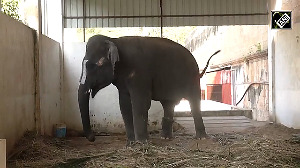The Sikkim government is planning to convert an artificial lake, formed by a massive landslide in the state’s northern part in August last year, into a tourist spot.
But most of the people from the Lepcha community in Dzongu argue that it is a bad idea to turn a “time-bomb” into a tourist spot, reports Athar Parvaiz.

On August 13 last year, a massive landslide blocked a tributary of the Teesta in the hills of Dzongu in the northern part of the Himalayan state of Sikkim, and the resultant accumulation of water formed a huge artificial lake in Mantam.
Months after the formation of the artificial lake, which has submerged a bridge and 14 houses apart from cutting off 14 villages with a population of over 2500 people from the rest of Sikkim, most of the Lepcha people in Dzongu say that the lake is nothing less than a “time-bomb” and want the water to be released from the huge artificial lake.
On the other hand, some elderly people, who have a strong belief in natural occurrences and worship nature, want the lake to stay intact, especially after it was named by the Sikkim government after the Lepcha patriarch, Thekong Tek.
Interestingly, the government has plans to convert the lake into a tourist spot. The district collector of north Sikkim, Karma Bonpo, said that people of the area want the artificial lake to stay intact so that it is turned into a tourist spot. However, people of Dzongu, especially the young and educated people, say the government is foisting its views on the local people.
“There are two reasons why the government says some locals want the artificial lake to stay intact. One, the government has named the lake as Thekong Tek who the Lepchas consider as their patriarch. And secondly, Lepchas of the older generation strongly believe in natural processes and nature worship. They feel that if nature has done it, it must stay as such,” said Dupjor Lepcha, a 33-year-old medical professional in Dzongu.
He said that he himself, and most of the people, especially the young people in Dzongu, feel that the lake can be a major threat for the people downstream as “it is nothing less than a time-bomb.”
Another young villager and entrepreneur, Gyatso Lepcha, said that the lake, apart from posing a serious threat to people downstream, has also cut off several villages from rest of Sikkim. “Those villagers are facing a lot of hardships ever since the bridge which they used to cross over got submerged,” Gyatso said.
The district collector, Bonpo, said the government has kept two motor boats and a manual raft to ferry the people of cut-off villages across the lake.
“We have deployed six people of the state disaster management response force who are helping the villagers to cross the lake,” Bonpo said and added that the villagers are requesting that a new bridge be constructed.
“We can’t always keep risk using boats for crossing the lake. It can be dangerous at times, particularly for children,” said Tshering Lepcha of Lengdem village which has lost the road connection to the rest of Sikkim because of the formation of the artificial lake.
“As of now, the state government is preparing a report following the instructions of the honourable high court about the stability of the lake and the views of the people on keeping the lake [or releasing its waters],” Bonpo said.
A dam designer at the Central Water Commission, who wished anonymity, said the lake should not remain intact as it can cause damage downstream in case of an earthquake or a major flood.
“Keeping the landslide-lake intact is certainly not a good idea. It is a landslide dam [lake] and not a well-designed and fully researched hydro dam. What if an earthquake or a massive flood causes a breach in it,” the designer said.
The Landslide and the Lake

A report by the National Remote Sensing Centre said the water impoundment, following the landslide, has resulted in the formation of a 2.2 km-long and 209 metres wide artificial lake, north of Mantam. The width of the landslide, the report said, is 530 metres at the centre and its length is 790 metres.
According to another report prepared by Nitya Nand Rai, Director, Central Water Commission (New Delhi), the estimated volume of the 65m high landslide dam (artificial lake) is about 7.55 million cubic metres.
The report says the blockage of rivers due to landslides in Himalayas and consequent formation of lakes behind landslide dams has been observed at a number of places in the recent past.
‘These landslide dams pose a major threat of flash flood to downstream areas in the event of their breaching. As landslide dams are quite porous, they are vulnerable to breach by cavity formation or overtopping. In the past a number of flash flood events have occurred due to breaching of landslide dams on river Parechu, Kurichhu, Phutkal etc,’ the report says.
This report is part of a series of stories supported by the Forum of Environmental Journalists in India in collaboration with the Ashoka Trust for Research in Ecology and Environment, under the Media Fellowships in Environmental Conservation (2016).








 © 2025
© 2025